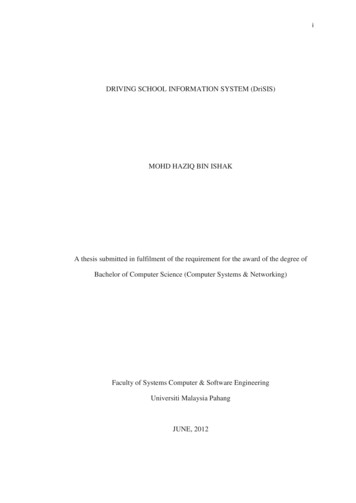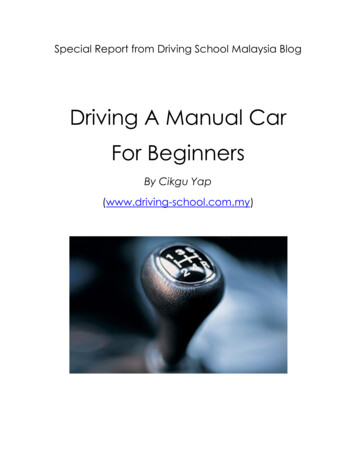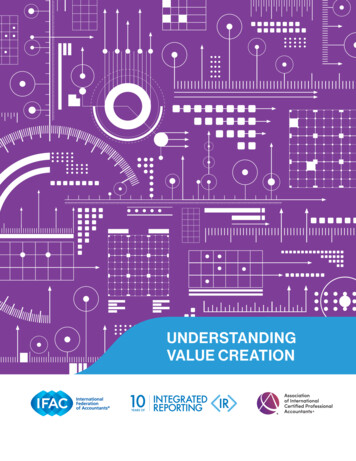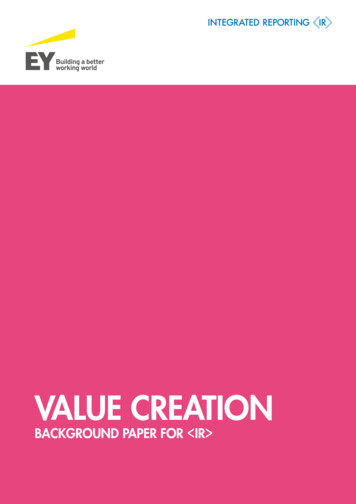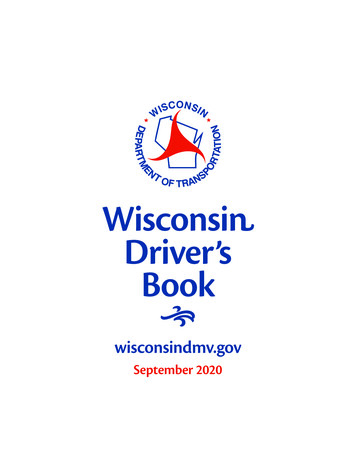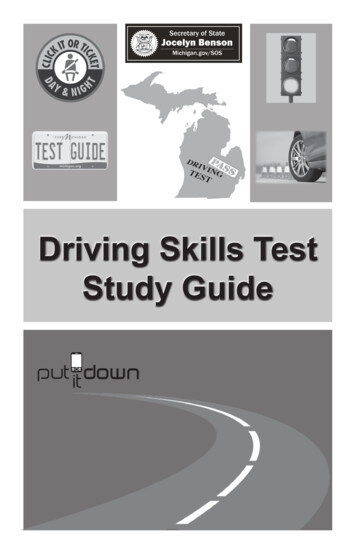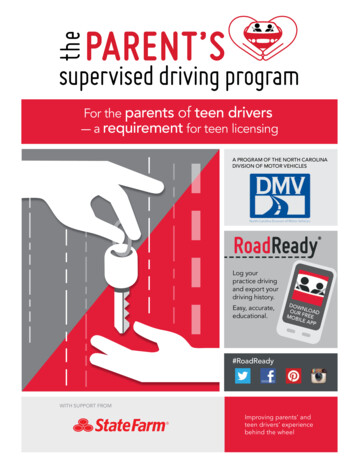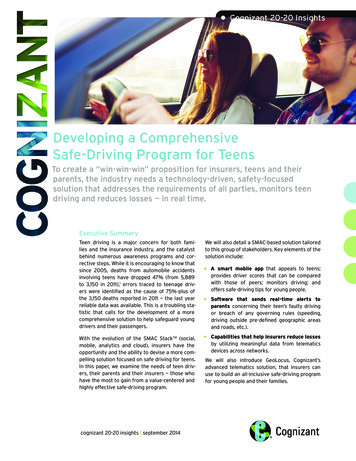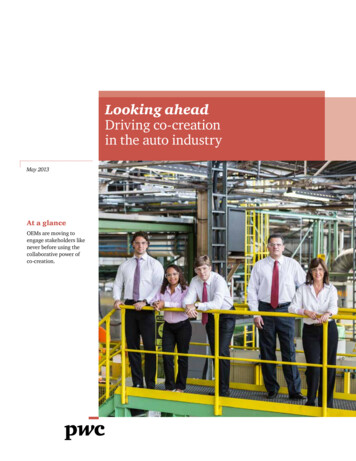
Transcription
Looking aheadDriving co-creationin the auto industryMay 2013At a glanceOEMs are moving toengage stakeholders likenever before using thecollaborative power ofco-creation.
IntroductionWhile auto companies develop products and technologies to meetconsumer demands in a 24/7 world, co-creation methods can provideoutlets to engage customers, dealers, employees and suppliers.Companies that successfully tap the feedback will be able to enhanceproducts, create in-depth customer experiences and gain a competitiveadvantage. How can companies better integrate technology solutionsto drive co-creation that results in collaboration among variousstakeholders through social media and other interactive outlets?OverviewIn recent years, existing methods ofcollaboration with customers havebegun to evolve into “co-creation.”Stakeholders are now interactingdirectly with companies in a two-waydialogue. The most common examplesare around discussion forums andproduct design. But now, servicesand many other company processesare also taking part in the discussion.There are already many exampleswhere automotive Original EquipmentManufacturers (OEMs) are takingthis approach.Social media is raising the bar onco-creation by giving companiesthe means to interact with virtuallyevery one of their stakeholders.Some companies are already takingadvantage of channels like YouTube,Pinterest, Twitter and Facebook, ordeveloping their own interactiveonline sites for customer communities.Companies that successfully tap intocustomer feedback and encourageinteractive involvement will be ableto enhance products, create in-depthcustomer experiences and improvetheir competitive position.2Looking aheadThere’s potential to engage otherstakeholders too, but these aren’tas common. For example, whilea number of OEMs are activelycollaborating with suppliers, relativelyfew are connecting in true enterpriseco-creation with their supplierecosystem. Companies may be ableto reduce costs and improve qualityby transforming these relationshipsand interactions. The same is true fordealerships. By involving the dealernetworks in enterprise co-creation,OEMs are likely to gain a significantcompetitive advantage.Enterprise co-creation:taking collaboration to thenext levelEnterprise co-creation is afundamentally different way oflooking at value generation betweenthe organization and its customers,suppliers, dealers, partners,employees, and public sector agencies.It is opening up business processesand reengineering them, so that theywork both ways. Tangible benefitsinclude revenue growth, improvedretention, and lower operatingcosts for enterprises, as well asincreased satisfaction and loyalty forstakeholders. It’s an approach that canbe especially valuable for automotivecompanies, who have looked toconnect with customers, suppliers,and dealer networks for decades.PwC believes that co-creation isultimately about increasing valuethrough innovative dialogue andpartnerships. Co-creation can makea significant impact on relationshipsacross the entire automotive valuechain. From product design anddevelopment to new vehicle salesand service, co-creation fosterstrue multi-directional collaborationamong customers, suppliers,dealers, service and supportorganizations and internally amongemployees. Even brand image canbe improved when organizationsuse co-creation to increaseeffectiveness of their corporate socialresponsibility programs.
Inter(Sche nal procesdulings, HR, esetc.)SOPand rojectdev deselo ignpment5432CA10M NBDKFLEHIGJSusalersalepan plied rmde col anve lab aglop or emm ativ enen e ttetyrat ibilirpo ponsoC esal Rco iDeNot all platforms are equally suited togetting there. Engagement platformscan range from simple channels forconveying information or answeringquestions to cooperative environmentsto truly collaborative systems (seeFigure 1). Even companies thatare already well on their way toimplementing co-creation are stilllikely to have gaps in some areas, asthe graph shows.Figure 1: Example of a potential co-creation landscape for an OEM withrelatively mature activitiesding anBrand olvementinvbrandCo-creation can take place using avariety of engagement platforms, suchas online communities, social networksites, crowd-sourcing techniques andcontests. But co-creation is more thanjust getting thousands of “followers”or “fans.” A company’s goal shouldbe to create an engaged, extendedcommunity that is committed to theproduct and company shown by theirinvolvement in collaborative activities.It’s ultimately a partnership betweenthe company and an individual,fueled by innovative experiences thatcan lead to positive outcomes foreveryone involved.Service and suppoprtLetters represent particular activities or projects. These are mapped to various levelsof maturity:1.One directional, Informational platform, unsolicited information2.Transactional platform where information is provided (i.e. a request, and a response)3.Platform supports co-operation where stakeholders work together toward their ownseparate goals with increasing interactions4.Platform supports coordination where stakeholders begin to change their beliefs,thoughts, and most importantly actions, based on information from other stakeholders5.Platform supports full collaboration where stakeholders work toward a common goal andopenly share information.Source: PwC analysisDriving co-creation in the auto industry3
While many companies are alreadyexploring co-creation, few of them aretruly making use of all the possibilitiesco-creation offers. For example,automakers are making great stridesin co-creation with customers throughproduct development and marketingwith interested fans. However,progress in other important areashas been much slower. And thoughsupplier collaboration is common,true co-creation with suppliers ismuch less prevalent. There is alsosignificant opportunity to leveragethe power of co-creation in areas likedealer relations, after-sales serviceand support, internal processes, andenhancing the company’s reputationfor corporate social responsibility.Moving beyond focusgroupsdialogue. It’s not optional. Newcar buyers are already using onlineinformation channels extensivelyto research different vehicles. Thegrowing access to almost unlimitedinformation and online communicationchannels has absolutely empoweredthe consumer. That is creating a bigopportunity for automakers.In the past, OEMs often relied oncustomer data obtained by surveys,focus groups, ethnography studies andsecondary market research to developnew products and redevelop existingofferings. But those approaches stillsometimes fell short. Although focusgroups were used, some new vehicleswere designed that didn’t appeal toconsumers. And even when vehicleswere very popular initially, somefailed to keep pace with changingconsumer preferences and wereeventually discontinued.Consumers are hungry for realtime, ongoing information sharingand active collaboration. Customerand enthusiast communities arealready emerging and beginningto have an impact on automotiveinnovation. These new and moreengaged participants in theproduct development process areproviding input into everythingfrom design concepts and technicalexpertise to design drawings andtechnical specifications.That’s why companies are now lookingto go beyond background researchand focus groups in initial designstages. Instead, the goal is to engagecustomers in an interactive, ongoingFigure 2: The Automobile—A Multitude of Engagement ChannelsFriendsStore ClerksCo-WorkersDriversBad DriversInjured DriversPoliceInsurance AgentRepair TechLooking aheadVacationersTravelingGolf BuddyDoing BusinessCommunicatingInn KeeperHandlingBreakdownsSinging, vigating,Trip PlanningInsuring andReporting ClaimsAvoiding ProblemsStoring andSecuringEating, SharingTheft ReportingFuelingGetting RepairsServicingMediaViewingService Mgr4FamilyWeb SearchTest DriveApp Store TechPurchaseCall adeApp SupportAttendantDMV Agent
“OEMs who leave their customers out of thedevelopment process risk falling behind thecompetition.”—Chad Mollin, PwC Management ConsultingCo-creating new designconceptsThere are a number of examples whereOEMs are getting customers involvedin the design process. Customers andfans can participate in a virtual worldto share ideas, participate in designcontests, suggest topics of interestand more. This is an opportunity forOEMs to gain knowledge and generateinnovative approaches to productdesign and integrated solutions.These virtual gathering places allowcustomers to rally around a newproduct launch or simply participatein the discussion. OEMs who leveragetechnology capabilities of the virtualwebsites can further drive traffic tothe retailer when the product comesto market.And while co-created design conceptsaren’t yet being mass-produced, thefirst concept cars have already createda lot of interest. Launched in Brazilin 2010, Fiat’s concept car, Fiat Mio,was based on more than 11,000 ideassubmitted by 17,000 subscribers inmore than 120 countries.1 Social mediasites Facebook and Twitter generatedsome of the ideas, and videos aboutthe “making of” the car are hostedon YouTube.Germany’s Volkswagen, in Englishthe ‘people’s car,’ decided to lookto the world’s largest car marketfor ideas. The company’s ‘People’sCar Project’ started up in China in2011. Volkswagen asked users of aninteractive website to submit theirideas and they did.1. “Is this the future of Automotive Design?” http://www.plminnovation.com/fiat mio.php; 0273.htmlThe official website received over35.6 million views, nearly 13 millionvisitors, more than 200,000 designsubmissions, and the followers of itsofficial micro blog topped 495,767.This open-innovation platform hasactivated a nationwide dialogue aboutfuture mobility. With the People’sCar Project, the Volkswagen brandbecame the “most digitalized autobrand in China.”2 Volkswagen turnedthree of the ideas into concept carsand launched them at the Beijing AutoShow in May 2012.We think that OEMs who leave theircustomers out of the developmentprocess risk falling behind thecompetition. As these examples show,some companies are already wellon their way. Automakers need toconsider how to reach out and connectwith customers.2. “Volkswagen crowdsources its way to a hover ayto-a-hover-car/22439/Driving co-creation in the auto industry5
A co-created vehicle fromenthusiasts, manufacturedby handLocal Motors takes co-creation severalsteps farther. It’s CEO, Jay Rogers,says the company is changing the waycars are designed, built and brought tomarket.3 The company crowd-sources,or co-creates car designs and thenmanufactures the new models on asmall scale in micro-factories. Thecompany uses a co-creation approachthroughout the value chain—designideas are crowd-sourced, and suppliersexchange information on parts via anopen-source network.4Local Motors’ co-creative challengebased platform, The Forge, wassuch a successful example othercompanies started using it too. Paccar’sPeterbilt Division is collaboratingwith Local Motors to conduct anonline competition, RIG2—RoadIcon Generation 2.5 The globalcompetition sought innovative designsfor a classic heavy duty truck exteriorthat used more aerodynamic andmodern elements.Local Motors’ own first vehicle, theRally Fighter, took just 18 months togo from a 2-D drawing to a vehicleready for pick-up. That compares to3. “Wie Co-Creation in der Automobil-Industriefunktioniert: Interview mit Jay Rogers von LocalMotors”, ers-von-local-motors/4. “Das Case Local Motors: Co-creation andcollaboration in the Automotive-industrie,”Universität St. Gallen, Double Yuu, T ads/2011/12/Local-Motors-Case-StudyFINAL1.pdf5. “Local Motors wants your help designing the nextPeterbilt rig” p?co 68&tab design-brief6Looking aheadthe industry standard of 3 to 5 years.The company wants to streamline evenfurther, with a goal of a 12 monthtimeline. Customers actually help buildtheir car; creating a unique experience.That was not the first time anautomaker has put some aspect ofmanufacturing directly in the handsof the car buyer. General Motors hasoffered buyers of its Chevrolet Corvettethe chance to build the enginesthemselves for an extra price andunder supervision—a uniquely literaltake on co-creation.6Using co-creation to marketproducts and enhancethe brandGetting the car buyer involved indesign and production will surely buildsignificant brand loyalty. In fact, OEMswho collaborate with stakeholders findmany ways to enhance both marketingand brand management.In Canada, Volkswagen used a cocreation strategy to engage thecompany’s fans in creating the thirdin a series of ads themed ‘Drive Until’for the company’s Golf compact car.Facebook users helped develop thescript for the ad, choose the actors, andselect the music. Fans could choose to6. http://blogs.forrester.com/doug williams/10-07-13gm takes co creation literallybe anonymous or to be included in thecredits. This co-creative model goeswell beyond traditional marketing andbuzz creation, by opening the doorto a two-way conversation with keystakeholders where their ideas areturned into reality.In today’s consumer-drivenmarketplace, providing opportunitiesfor the public to share their ideas,enthusiasm, and complaints is thekey to building strong relationships.That may mean using existing socialmedia networks like Facebook, Twitterand YouTube, participating in newcommunities set up by enthusiasticfans, or interacting on cross-industrysocial websites. This is a way OEMs canact as peers in these new communities,sharing ideas or just listening to whatcustomers are saying about theirvehicles. Engagement platforms likethese are now shaping perceptionsof car brands, so OEMs need to takethem seriously.Automotive companies do not needto be constrained to existing socialmedia platforms either. Some OEMsnow have their own interactive onlinecommunities. For example, Ford’sinteractive site, Ford Social helpsto build customer-loyalty, promotetwo-way interaction and help spreadkey messages.
Beyond the customerCustomers are just the beginning. Cocreation has the potential to reshapeinteraction with virtually all internaland external stakeholders includingsuppliers, dealers, service and supportand internal audiences.Working together withsuppliersCo-creation platforms have been usedfor years to enhance relationshipsbetween OEMs and their suppliers;these run the gamut from onlineinformation sharing websites, to colocation facilities in business parks andbusiness model transformations.During the design stage, co-creationplatforms have become particularlyimportant. While in-person designworkshops are still common forpartners who are located relativelyclose, virtual platforms have becomedominant. Internal Team web portalsand supplier portals, where peopleshare everything from CAD drawingsto test results within an environmentthat can be adapted by all participants,are the most common today.Using co-creation strategies isone important way that OEMs areincluding their suppliers much earlierin their innovation processes, whichcan increase supplier commitment,transparency and trust,7 whichleads to lower pricing, increasedtechnology sharing and higher supplierrelationship rankings.Over the past decade, Ford has madebig improvements in its workingrelations with suppliers,8 citingincreased collaboration with keysuppliers as one important reason.7. 2011 PPI NA Automotive OEM—Supplier WorkingRelations Study8. Ibid.In September 2005, Ford introducedits ‘Aligned Business Framework’(ABF) to strengthen collaborationand develop a sustainable businessmodel to drive mutual profitabilityand technology development.9 As partof the framework, Ford is involvingsuppliers earlier in the productdevelopment process.And while co-creation may oftenstart with the design phase, it doesn’tend there. Shared manufacturingstrategies, like just-in-sequencedelivery and joint testing, can alsoprovide great opportunities for OEMsto co-create with their suppliers. Socan more transparency. Ford’s ABF alsoincludes sharing more information onforecast volumes and product planswith suppliers.9. “FORD, KEY SUPPLIERS ROLL OUT INNOVATIVEBUSINESS MODEL” http://media.ford.com/article display.cfm?article id 21677Driving co-creation in the auto industry7
Interacting with dealersA strong relationship with the dealernetwork has long been seen as criticalto OEMs’ success. By collaboratingwith dealers, companies can marketvehicles more effectively. Excellentcustomer service at the dealerlevel is also critical to developing astrong brand.It’s not always smooth sailing though.In the US, for example, recent hardtimes in the automotive industrydrove thousands of dealerships outof business. Many OEMs found thatrelationships with the survivingdealerships were tense as a result.By implementing co-creationplatforms together with dealers,OEMs can actively foster collaborationdownstream. That can help them reachout to the customer together withdealers, and enhance relationshipswith dealer networks too.That’s especially important, since allaround the world dealers are facingnew challenges that go well beyondthe economic environment. Consumershopping behavior is changingsignificantly. Online informationresources mean that new and usedcar buyers now have instant accessto vehicle inventory availability andprice transparency through online8Looking aheadsearch engines such as Auto Trader.com, Edmunds.com and KBB.com.That means more pressure on prices,since new car buyers can comparisonshop in a way they never could have inthe past.In the past, the dealership was theprimary site of interaction with a carbrand, but that’s expanding now.Third-party sites and the OEMs’ owndigital platforms—particularly mobileand social—provide the potential fora whole host of other interactions.Making sure that dealers are linkedinto such efforts is critical. Whendealers work together with OEMs anddevelop robust co-creation platforms,they can enhance traffic into dealerstorefronts, improve how the customerinteracts with both the dealer andthe OEM, increase sales and build therelationship between the dealer andthe OEM too.Connected carsJust how interactive will cars be?Automakers are starting to explorethe possibilities.Toyota’s “Fun Vii” concept car—Viistands for vehicle interactive internet—made waves at the Tokyo Auto Showin 2011. Its touch screen exterior canchange to suit the drivers’ mood. Theconcept car can also connect to thedealer’s website for a check-up.In 2007, Ford and others developeda connectivity platform, called SYNCthat allows users to make hands-freetelephone calls, control music andperform other functions with the useof voice commands in the vehicle.Now, the automaker is working onincorporating a series of in-car healthand wellness apps and services aimedat monitoring people with chronicillnesses, into vehicles.In the area of diabetes, Fordresearchers have developed aprototype system that allows FordSYNC to connect via Bluetooth toa continuous glucose monitoringdevice and share glucose levels andtrends through audio alerts and visualdisplays for drivers or passengers. Thesystems envisioned would be able tointeract with drivers’ other devices,like smart phones and then relay thisinformation to health care providers bystoring the data in the cloud.Using a co-creation approach to getinput not only from customers, butalso from a whole range of otherstakeholders, will be vital in movingother innovations like these forward.
OEMs and suppliers are already workingtogether to make vehicles more connected—carsare starting to become a “social” product.Big opportunities in serviceand supportIn the US, a recent survey reportedthat only around 33% of customerstrust dealer repair and service facilitiesto conduct their repairs.10 Further,over 80% of respondents indicatedthey wouldn’t use dealers for out ofwarranty repair work. That’s a lot oflost potential opportunity for dealers.OEMs and suppliers are alreadyworking together to make vehiclesmore connected—cars are startingto become a “social” product.There’s a big opportunity to build inconnectivity with dealers and otherafter-sales support providers too. Newinfotainment and other electronicsystems should also work togetherwith dealers and customers to identifythe best way to provide transparencyto the vehicle operation and servicerequirements. They’ll need to takeinto account the driver’s desire forprivacy and leave freedom for selectinga preferred service location, but stillconnect interactively with dealernetworks (and potentially other serviceproviders as well). Some automakersare already working on such concepts(see Connected cars).When the tire pressure is low or theoil needs a change, for example, thecar could not only alert the driver—it could potentially show possiblelocations to have the service done. Ifdealers see that a car will be in need ofservice, they can reach out to the driverand let them know. That might includeoffering a discount at the right time orincluding functionality that lets driversmake service appointments directlyfrom the vehicle’s interface. Customersbenefit too, by obtaining a clear viewof what their service requirements are,and can quickly identify a dealer thatcan perform necessary maintenance orrepairs at an acceptable cost.10. Source: AutoMD.comDriving co-creation in the auto industry9
Internal collaboration andemployee innovationsWorking with stakeholdersin the communityCo-creation can also be a usefultool to build relationships within anorganization. Establishing the rightinteractive engagement platformsto reach out to employees can beespecially powerful as part of internalchange programs, or as a way to fosteran innovation culture throughoutthe organization. When companiesreally engage their employees andnot only ask for their ideas, butalso implement them, employeesatisfaction and morale goes way up.And since satisfied employees are moreproductive and less likely to leave thecompany, there’s a direct impact on thebottom line.Consumers and society in generalhave become increasingly focusedon a firm’s economic, social andenvironmental impact, or the “triplebottom-line”. With informationthat is easy to share, companies thatdon’t uphold high standards in theseareas quickly suffer damage to theirreputation and subsequently theirprofitability. The continued growthof Corporate Social Responsibilityprograms (CSR) across manyindustries has shown how firmprofitability improves with the“greening” of a firm’s business.However, while many companieshave developed CSR programs, thereis a growing sense of complacencyin communicating them and theirimpacts. Further, there is a risk of theperception of “greenwashing”—wherewhat is reported in terms of impact isnot the true performance.New tools and resources cantake internal collaboration to anentirely new level. But good onlinecollaboration tools alone aren’t enoughto really fuel an internal culture ofco-creation or gain efficiency benefits.Automotive companies also needto listen to the voices of employeeswho will actually use these tools intheir day-to-day interactions. Indeed,collaboration tools work best whenthey are co-created with employees.Implementing new HR systems tostreamline time reports, for example,can potentially save companies a lotof administrative time. But they needto make sure that systems work wellfor employees. That’s easier if staff isincluded in the development process.There are many other ways to co-createwith employees. With many companiesnow operating with a smaller staff,looking to every employee as a possiblesource of new ideas and informationcan make the difference betweensurviving and thriving.10Looking aheadWith multiple reporting standardsthat can be used, such as: GlobalReporting Initiative (GRI), ISO 26000and 14000 and Social AccountabilityInternational (SAI) just to name a few,there is a significant challenge for firmsin deciding what to report and how toreport it. Firms that have a co-creativemind set, recognize that social mediacan be a very effective platform formoving beyond the often long and dullannual CSR reports to more dynamic,transparent and targeted reporting.Some firms are even now beginningto utilize social media platforms suchas facebook and twitter to report theirCSR performance11 with a goal toengage actively with participants whobecome a following to a firm’s CSRperformance. This not only helps buildtrust with stakeholders and interestedparties but also allows firms to bettergauge overall sentiment early on.OEMs recognize that they are oftenunder the spotlight when it comesto the impacts that automobileshave on society at large. Cars areintimately linked to environmentalconcerns, public safety and economicsustainability. By leveraging many ofthe same platforms and techniquesused to reach out to consumers,suppliers and dealers, OEMs couldbuild interactive dialogues withother stakeholders that may not beso interested in what the design ofa vehicle looks like, or how it’s puttogether, but are rather interested withthe impacts on the environment andsociety that comes with building andadding another vehicle to the road.Through cocreation and the utilizationof social media platforms, OEMs cangain the capability to quickly identifywhat needs to be communicated,gauge overall sentiment and reactearlier to concerns that may emerge.11. 2012/01/18/the-top-10trends-in-csr-for-2012/
What’s next?Co-creation is already starting toemerge as a mainstream method ofcollaboration and idea generation inthe automotive industry. We believethe pace of implementation willincrease significantly over the next fiveyears. Automakers should embrace thisnew level of openness and stakeholderinteraction and leverage the significanttools and resources available. We thinkthose that do this most effectivelywill be well-positioned to create asustainable leadership position forthe future.How PwC can support yourco-creation effortWe help our clients give stakeholdersmore active and direct responsibility inplanning, innovation, operations, anddelivery. PwC Management Consultingcan work with your organization toexplore how co-creation can propelyour business to the next level invarious ways: Product and Service Co-Creation Public-Sector and Multi-StakeholderPolicy Co-Creation New Business, Ecosystem, andBusiness Model Co-Creation Business Interaction Redesign Enterprise Co-Creation Assessment Customer Experience Co-Creation Supply Chain Co-CreationDriving co-creation in the auto industry11
www.pwc.comTo hear how our services couldbenefit your organization,please contact:Dietmar OstermannGlobal Automotive Advisory Leader 1 313 394 3220dietmar.ostermann@us.pwc.comDoug BillingsPrincipal, Co-Creation Specialist617 530 6163douglas.s.billings@us.pwc.comChad MollinManager, NA Automotive ManagementConsulting Practice 1 224 622 2593chad.a.mollin@us.pwc.com 2013 PwC. All rights reserved. PwC refers to the PwC network and/or one or more of its member firms, each of which is a separate legal entity. Please seewww.pwc.com/structure for further details.This content is for general information purposes only, and should not be used as a substitute for consultation with professional advisors. PwC helps organisationsand individuals create the value they’re looking for. We’re a network of firms in 158 countries with more than 180,000 people who are committed to delivering qualityin assurance, tax and advisory services. Tell us what matters to you and find out more by visiting us at www.pwc.com. LA-13-0260 SL
enterprise co-creation is a fundamentally different way of looking at value generation between the organization and its customers, suppliers, dealers, partners, employees, and public sector agencies. it is opening up business processes and reengineering them, so that they work both ways. tangible benefits include revenue growth, improved
